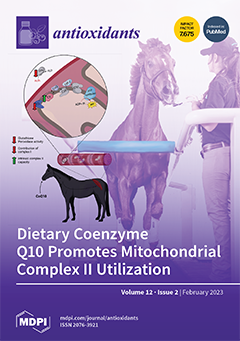Cratoxylum formosum ssp.
pruniflorum (Kurz.) Gogel (Guttiferae), called kuding tea, is widely distributed in Southeast Asia. In this study, the constituents and biological activity of
C. formosum ssp.
pruniflorum were investigated. Extract of its leaves, roots and stems showed antioxidant and α-glucosidase inhibitory
[...] Read more.
Cratoxylum formosum ssp.
pruniflorum (Kurz.) Gogel (Guttiferae), called kuding tea, is widely distributed in Southeast Asia. In this study, the constituents and biological activity of
C. formosum ssp.
pruniflorum were investigated. Extract of its leaves, roots and stems showed antioxidant and α-glucosidase inhibitory activity. Interestingly, comparison of the metabolite profiles of leaves, roots and stems of
C. formosum ssp.
pruniflorum by LC-MS analysis showed a great difference between the roots and leaves, whereas the roots and stems were quite similar. Purification of the roots and leaves of
C. formosum ssp.
pruniflorum through various chromatographic techniques resulted in the isolation of 25 compounds. The structures of isolated compounds were elucidated on the basis of spectroscopic analysis as 18 xanthones, 5 flavonoids, a benzophenone and a phenolic compound. Among them, a xanthone (
16) and a benzophenone (
19) were first reported from nature. Evaluation of biological activity revealed that xanthones had a potent α-glucosidase inhibitory activity, while flavonoids were responsible for the antioxidant activity. To maximize the biological activity, yield and total phenolic content of
C. formosum ssp.
pruniflorum, extraction conditions such as extraction solvent, time and temperature were optimized using response surface methodology with Box–Behnken Design (BBD). Regression analysis showed a good fit of the experimental data, and the optimal condition was obtained as MeOH concentration in EtOAc, 88.1%; extraction time, 6.02 h; and extraction temperature 60.0 °C. α-Glucosidase inhibitory activity, yield and total phenolic content under the optimal condition were found to be 72.2% inhibition, 10.3% and 163.9 mg GAE/g extract, respectively. These results provide useful information about
C. formosum ssp.
pruniflorum as functional foods for oxidative stress–related metabolic diseases.
Full article






